A Rainfall Data Intercomparison Dataset of RADKLIM, RADOLAN, and Rain Gauge Data for Germany
Abstract
1. Summary
2. Data Description
- Radar_comparison.shp: Point data of the centroids of the RADKLIM data grid (1 km resolution) clipped to Germany. The spatial reference is a polar-stereographic projected Cartesian coordinate system defined by DWD for their radar composite products (see [13] for more details on this custom projection referred to as ‘radar projection’ throughout this paper). This file is subsequently referred to as ‘RADKLIM and RADOLAN radar precipitation dataset’ or ‘radar shapefile’.
- Gauge_comparison.shp: Point data of rain gauges with the geographic coordinate system WGS 84 as a spatial reference. This shapefile is subsequently referred to as ‘rain gauge precipitation dataset’ or ‘rain gauge shapefile’.
3. Materials and Methods
3.1. RADKLIM and RADOLAN Radar Precipitation Dataset
3.1.1. Data Sources and Accessibility
- (a)
- The hourly RADOLAN RW composite
- (b)
- The hourly RADKLIM RW composite
- (c)
- A Shuttle Radar Topography Mission (SRTM) Digital Elevation Model
- (d)
- A dataset on the distribution and properties of wind energy plants
3.1.2. Data Processing, Aggregation, and Validation
3.2. Rain Gauge Precipitation Dataset
3.2.1. Data Source and Accessibility
3.2.2. Data Processing, Aggregation and Validation
- Several extremely high minute values (121 min intervals between 312.44 and 487.56 mm at station 01669 in January 2008), which are regarded as impossible. Consequently, all intervals exceeding 100 mm were replaced by NaN in the HDF5 file without any further checks. The high threshold of 100 mm was chosen in order to ensure that no heavy rainfall events that may have been saved as aggregated value (e.g., a daily sum), e.g., due to hardware issues, are erased from the data without any further checks.
- Very high values with missing entries or zeros in the raw data several minutes or hours beforehand (e.g., 57.27 mm at station 07104 at 06.06.2011 10:49 with previous entry 0.0 mm at 10:02; 55.17 mm at station 05158 at 30.09.2006 13:08 with previous entries all 0.0 mm). Such high values could be either erroneous data or also sum values for a previous time period during which a malfunction of the gauge occurred and the precipitation sum was added later. For such values, it is difficult to tell which of these cases holds true and how long the summarized period has been. However, as the gauge dataset needs to be reliable at least at an hourly temporal resolution for subsequent comparison to the radar data, a three-step validation was applied: First, all intervals exceeding 4 mm/min were regarded as potentially erroneous and identified from the HDF5 file. Second, for all exceeding intervals, the precipitation values of the gauge during the previous hour were checked. If there are any non-zero precipitation values, the gauge was assumed to have worked correctly and the value was kept. Third, if the gauge indicated no precipitation during the previous hour, the precipitation amount of the two adjacent hours of the corresponding RADKLIM pixel was consulted. If any of these indicated precipitation, the gauge value was kept. If both hours have a value of 0.0 mm at the RADKLIM pixel, the exceeding gauge value was set to NaN since it can either be considered as erroneous or the actual precipitation may have occurred at some unknown time in the past and the value is not representative for the point of time under review.
- Sequences of several consecutive minutes with remarkably high values (e.g., at station 02532 on 15.06.2006, there are four consecutive entries with 10.75 mm/min between 8:01 and 8:04 AM). To address potential errors due to value repetitions in the data and their potentially significant effects on data aggregation results, the intervals exceeding 4 mm/min were additionally checked for the time between exceedances. If there are more than two consecutive intervals exceeding 4 mm/min, all intervals starting from the third were set to NaN.
3.3. Merging the Datasets
3.3.1. Methodology
3.3.2. Resulting Dataset
4. Data Use and Application
- compare the rainfall datasets with each other and evaluate their quality,
- identify the dataset best-suited for the respective study area and application,
- improve the understanding of the inherent bias and error structure, especially of the two radar datasets, and to
- provide precipitation maps and statistics as well as model inputs for the covered time period.
Author Contributions
Funding
Acknowledgments
Conflicts of Interest
References
- Thorndahl, S.; Einfalt, T.; Willems, P.; Nielsen, J.E.; Veldhuis, M.C.T.; Arnbjerg-Nielsen, K.; Rasmussen, M.R.; Molnar, P. Weather radar rainfall data in urban hydrology. Hydrol. Earth Syst. Sci. 2017, 21, 1359–1380. [Google Scholar] [CrossRef]
- Krajewski, W.F.; Kruger, A.; Smith, J.A.; Lawrence, R.; Gunyon, C.; Goska, R.; Seo, B.C.; Domaszczynski, P.; Baeck, M.L.; Ramamurthy, M.K.; et al. Towards better utilization of NEXRAD data in hydrology: An overview of Hydro-NEXRAD. J. Hydroinformatics 2011, 13, 255–266. [Google Scholar] [CrossRef]
- Seo, B.C.; Krajewski, W.F.; Kruger, A.; Domaszczynski, P.; Smith, J.A.; Steiner, M. Radar-rainfall estimation algorithms of Hydro-NEXRAD. J. Hydroinformatics 2011, 13, 277. [Google Scholar] [CrossRef]
- Leijnse, H.; Uijlenhoet, R.; Hazenberg, P. Radar rainfall estimation of stratiform winter precipitation in the Belgian Ardennes. Water Resour. Res. 2011, 47, 257. [Google Scholar]
- Gjertsen, U.; Salek, M.; Michelson, D.B. Gauge-adjustment of radar-based precipitation estimates–a review. Cartogr. Perspect. 2003, 1. [Google Scholar] [CrossRef]
- Goudenhoofdt, E.; Delobbe, L. Evaluation of radar-gauge merging methods for quantitative precipitation estimates. Hydrol. Earth Syst. Sci. 2009, 13, 195–203. [Google Scholar] [CrossRef]
- Berne, A.; Krajewski, W.F. Radar for hydrology: Unfulfilled promise or unrecognized potential? Adv. Water Resour. 2013, 51, 357–366. [Google Scholar] [CrossRef]
- MeteoSolutions GmbH. Projekt RADOLAN–Routineverfahren zur Online-Aneichung der Radarniederschlagsdaten mit Hilfe von Automatischen Bodenniederschlagsstationen (Ombrometer). Zusammenfassender Abschlussbericht für die Projektlaufzeit von 1997 bis 2004. Available online: https://www.dwd.de/DE/leistungen/radolan/radolan_info/abschlussbericht_pdf.pdf?__blob=publication File&v=2 (accessed on 19 April 2018).
- Winterrath, T.; Rosenow, W.; Weigl, E. On the DWD Quantitative Precipitation Analysis and Nowcasting System for Real-Time Application in German Flood Risk Management. IAHS Publ. 2012, 351, 323–329. [Google Scholar]
- Erstellung Einer Radargestützten Niederschlagsklimatologie; Berichte des Deutschen Wetterdienstes No. 251. 2017. Available online: https://www.dwd.de/DE/leistungen/pbfb_verlag_berichte/pdf_einzelbaende/ 251_pdf.pdf?__blob=publicationFile&v=2. (accessed on 29 March 2019).
- RADKLIM Version 2017.002: Reprocessed Gauge-Adjusted Radar Data, One-Hour Precipitation Sums (RW). Available online: https://opendata.dwd.de/climate_environment/CDC/grids_germany/hourly/ radolan/reproc/2017_002/bin (accessed on 25 June 2019).
- RADKLIM Version 2017.002: Reprocessed Quasi Gauge-Adjusted Radar Data, 5-Minute Precipitation Sums (YW). Available online: https://opendata.dwd.de/climate_environment/CDC/grids_germany/ 5_minutes/radolan/reproc/2017_002/bin/ (accessed on 25 June 2019).
- Deutscher Wetterdienst. RADKLIM: Beschreibung des Kompositformats und der Verschiedenen Reprozessierungsläufe. Version 1.0. 2018. Available online: https://www.dwd.de/DE/leistungen/ radarklimatologie/radklim_kompositformat_1_0.pdf;jsessionid=0889B3A8CB74341FAA652DB2A4FB7F63.live11041?__blob=publicationFile&v=1 (accessed on 26 March 2019).
- A Rainfall Data Inter-Comparison Dataset for Germany: Version 1.0. Available online: https://zenodo.org/ record/3262172 (accessed on 29 June 2019).
- Deutscher Wetterdienst. RADOLAN und RADVOR: Beschreibung des Kompositformats. Version 2.4.4. 2018. Available online: https://www.dwd.de/DE/leistungen/radolan/radolan_info/radolan_radvor_op_ komposit_format_pdf.pdf?__blob=publicationFile&v=11 (accessed on 26 March 2019).
- Eichhorn, M.; Scheftelowitz, M.; Reichmuth, M.; Lorenz, C.; Louca, K.; Schiffler, A.; Keuneke, R.; Bauschmann, M.; Ponitka, J.; Manske, D.; et al. Spatial Distribution of Wind Turbines, Photovoltaic Field Systems, Bioenergy, and River Hydro Power Plants in Germany. Data 2019, 4, 29. [Google Scholar] [CrossRef]
- Radproc–A Gis-Compatible Python-Package for Automated Radolan Composite Processing and Analysis; Zenodo. 2018. Available online: https://zenodo.org/record/2539441 (accessed on 25 June 2019).
- Mckinney, W. pandas: A Foundational Python Library for Data Analysis and Statistics. Available online: https://www.dlr.de/sc/Portaldata/15/Resources/dokumente/pyhpc2011/submissions/pyhpc2011_submission_9.pdf (accessed on 31 July 2019).
- Hierarchical Data Format. Available online: https://portal.hdfgroup.org (accessed on 18 December 2018).
- Kreklow, J. Facilitating radar precipitation data processing, assessment and analysis: A GIS-compatible python approach. J. Hydroinformatics 2019, 21, 652–670. [Google Scholar] [CrossRef]
- Oliphant, T.E. A Guide to NumPy; CreateSpace: Scotts Valley, CA, USA, 2006. [Google Scholar]
- Stephan, K. Erfahrungsbericht zur Verwendung des PULL-Kompositverfahrens zur Erstellung des Radolan-Komposits (RZ-Komposit). DWD Interner Ber. 2007, in press. [Google Scholar]
- RADOLAN-Information Nr. 17. Available online: https://www.dwd.de/DE/leistungen/radolan/ radolan_info/radolan_info_nr_17.pdf?__blob=publicationFile&v=3 (accessed on 17 June 2019).
- Weigl, E.; Winterrath, T. Radargestützte Niederschlagsanalyse und –vorhersage (RADOLAN, RADVOR-OP). Promet 2009, 35, 78–86. [Google Scholar]
- Tukey, J. Exploratory Data Analysis; Addison-Wesley: Reading, MA, USA, 1977. [Google Scholar]
- Germann, U.; Galli, G.; Boscacci, M.; Bolliger, M. Radar precipitation measurement in a mountainous region. Q. J. R. Meteorol. Soc. 2006, 132, 1669–1692. [Google Scholar] [CrossRef]
- Meischner, P. Weather Radar: Principles and Advanced Applications, 1st ed.; Springer: Berlin/Heidelberg, Germany, 2004. [Google Scholar]
- Project Jupyter. Jupyter Notebook, 2014–2019. Available online: https://jupyter.org/ (accessed on 17 June 2019).
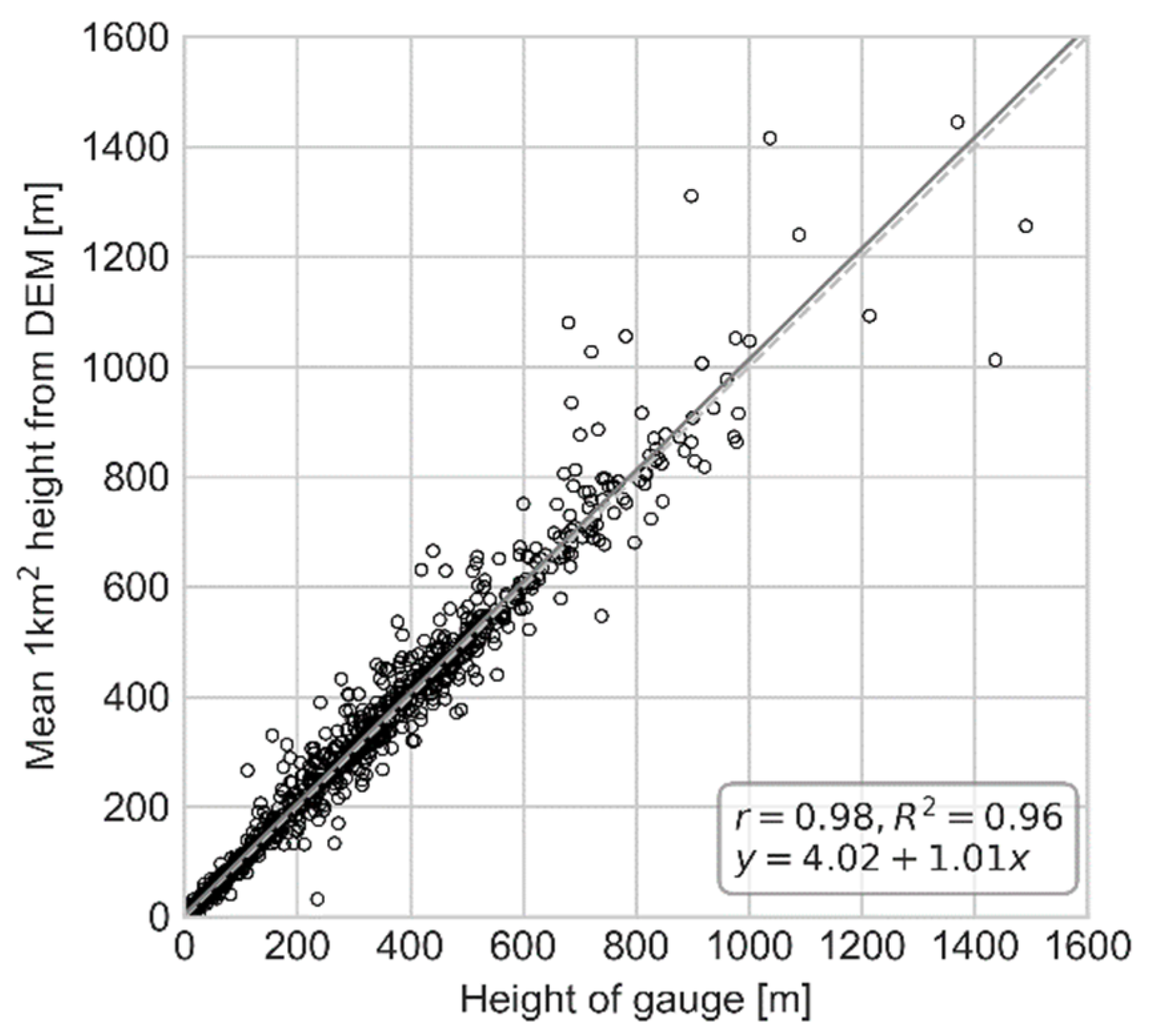
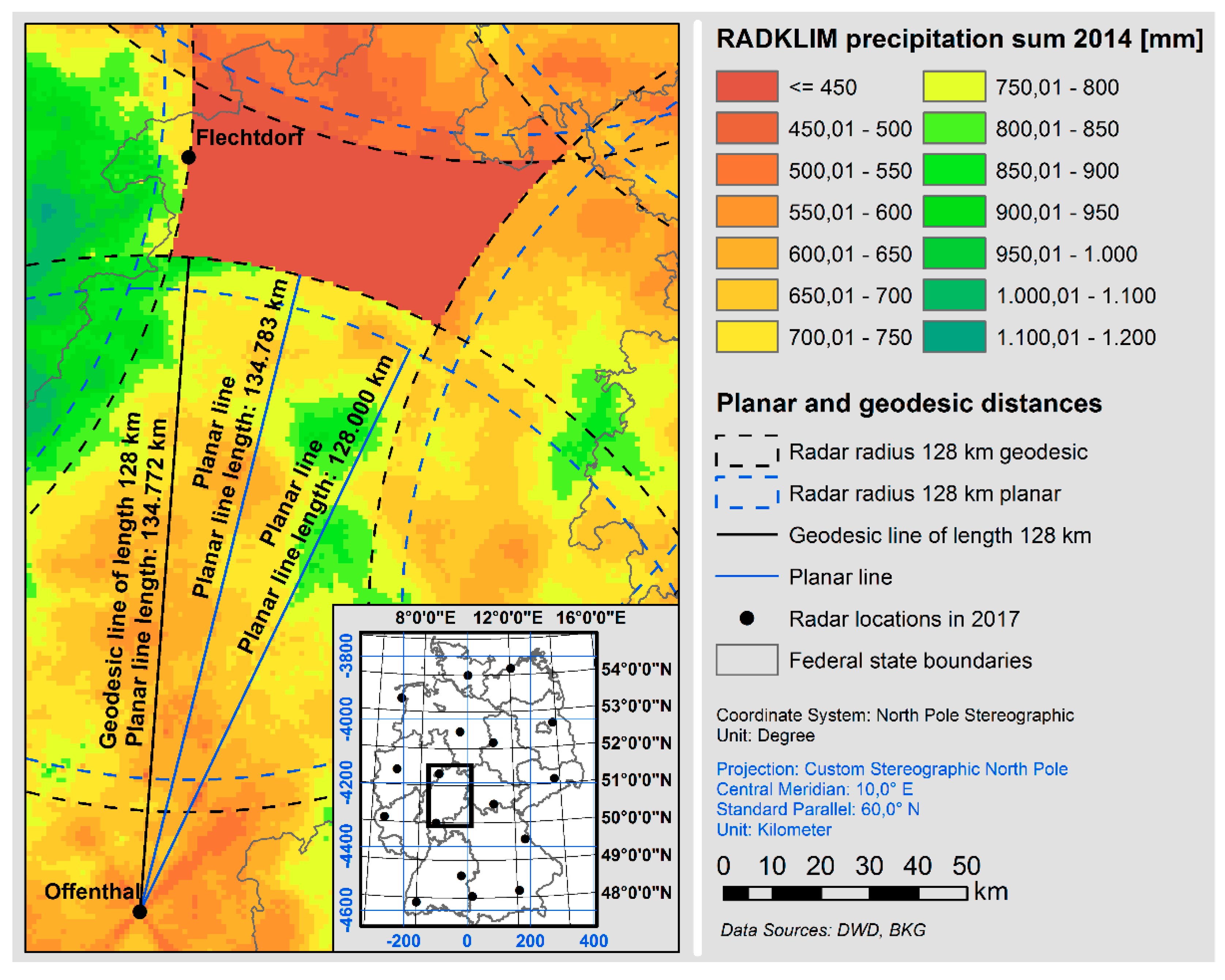
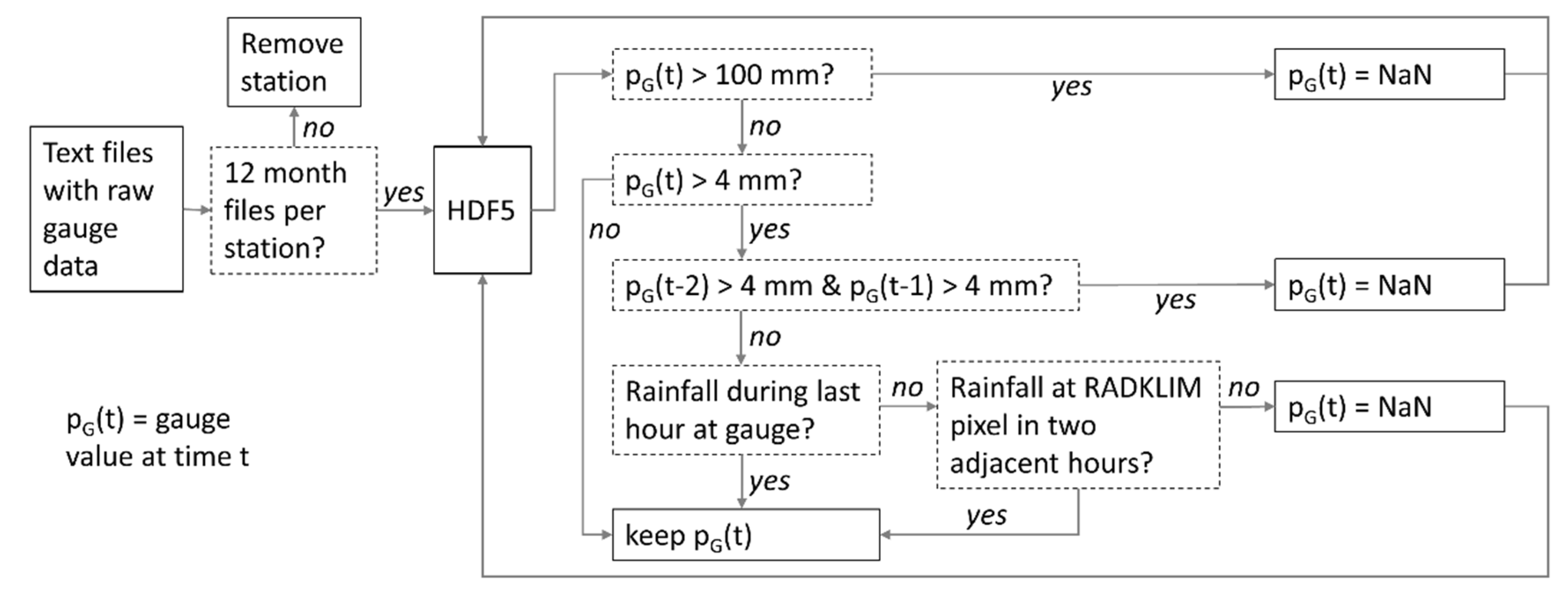
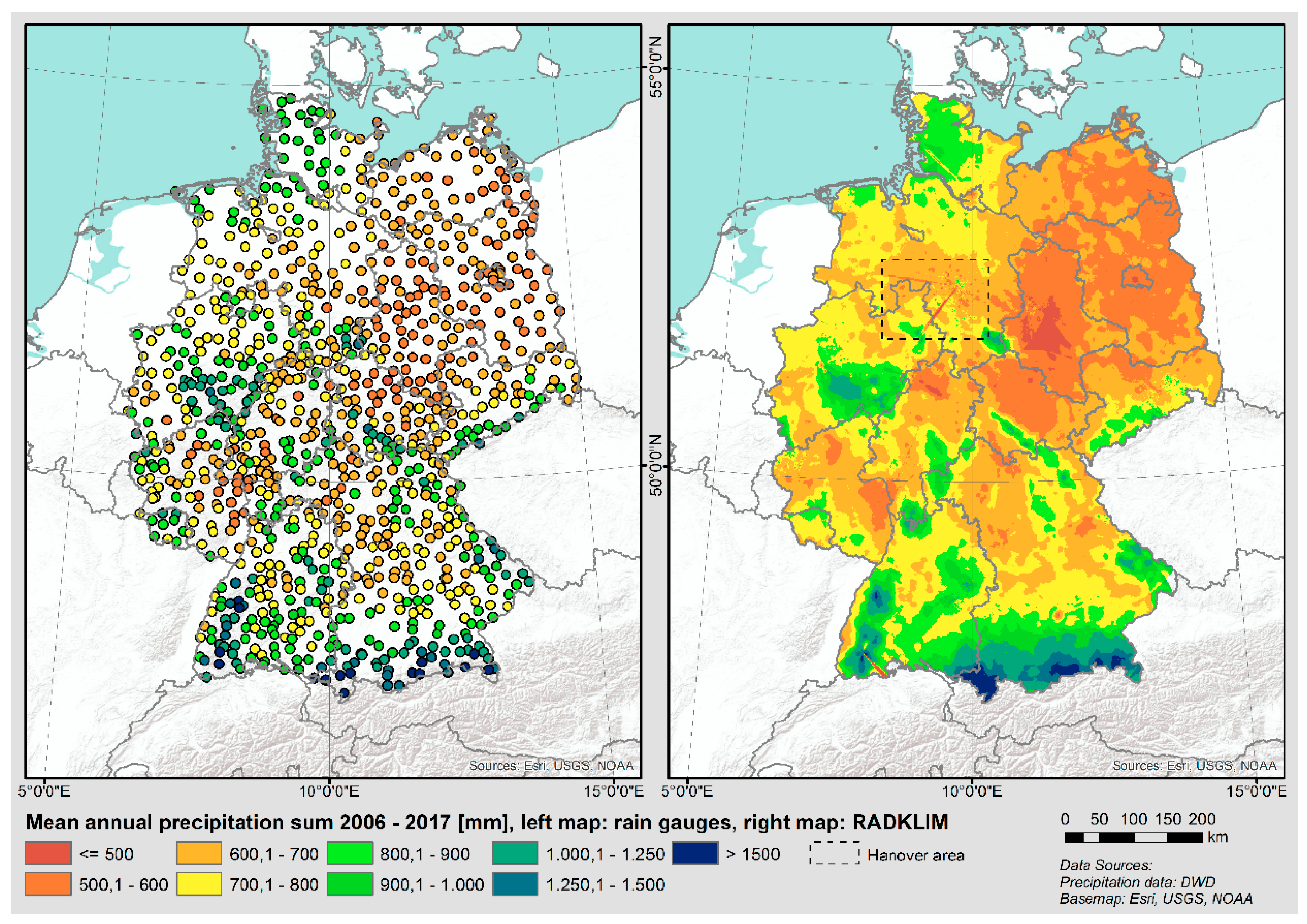
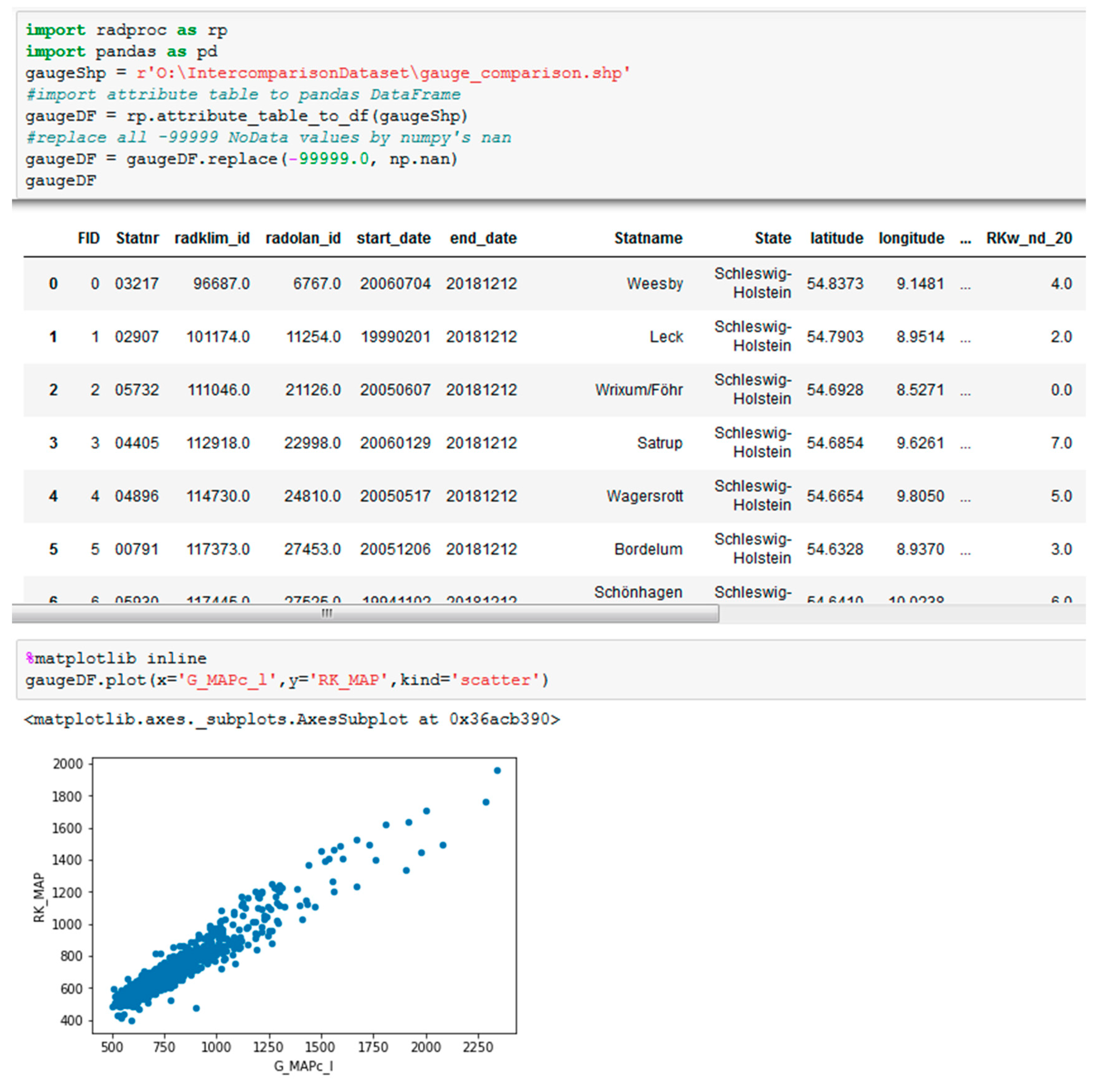
| Field Name | Parameter Description | Unit |
|---|---|---|
| *MAP | Mean annual precipitation sum 2006–2017 | mm |
| **MAPc | Mean annual precipitation sum cleaned from extreme outliers | mm |
| *MAPc_l | Mean annual precipitation sum cleaned from extreme lower outliers | mm |
| *MSP | Mean summer precipitation sum (May–October) | mm |
| *MWP | Mean winter precipitation sum (November–April) | mm |
| *2006, …, *2017 | Precipitation sum of the year 2006, 2007, …, 2017 | mm |
| *nnan | Total number of NoData entries in the period 2006–2017 | - |
| *s_nd_1 | Number of days exceeding a precipitation sum of 1 mm in the summer | - |
| *s_MDP_1 | Mean precipitation of all days exceeding a precipitation sum of 1 mm in the summer | mm |
| *s_nd_20 | Number of days exceeding a precipitation sum of 20 mm in the summer | - |
| *s_MDP_20 | Mean precipitation of all days exceeding a precipitation sum of 20 mm in the summer | mm |
| *w_nd_1 | Number of days exceeding a precipitation sum of 1 mm in the winter | - |
| *w_MDP_1 | Mean precipitation of all days exceeding a precipitation sum of 1 mm in the winter | mm |
| *w_nd_20 | Number of days exceeding a precipitation sum of 20 mm in the winter | - |
| *w_MDP_20 | Mean precipitation of all days exceeding a precipitation sum of 20 mm in the winter | mm |
| height_dem | Average height above sea level per radar pixel | m |
| nwep | Number of wind energy plants in the respective radar pixel | - |
| wep_height | Average hub height of all wind energy plants per pixel | m |
| wep_dia | Average rotor diameter of all wind energy plants per pixel | m |
| **dist10 | Distance to closest radar station in the year 2010 | km |
| **dist17 | Distance to closest radar station in the year 2017 | km |
© 2019 by the authors. Licensee MDPI, Basel, Switzerland. This article is an open access article distributed under the terms and conditions of the Creative Commons Attribution (CC BY) license (http://creativecommons.org/licenses/by/4.0/).
Share and Cite
Kreklow, J.; Tetzlaff, B.; Kuhnt, G.; Burkhard, B. A Rainfall Data Intercomparison Dataset of RADKLIM, RADOLAN, and Rain Gauge Data for Germany. Data 2019, 4, 118. https://doi.org/10.3390/data4030118
Kreklow J, Tetzlaff B, Kuhnt G, Burkhard B. A Rainfall Data Intercomparison Dataset of RADKLIM, RADOLAN, and Rain Gauge Data for Germany. Data. 2019; 4(3):118. https://doi.org/10.3390/data4030118
Chicago/Turabian StyleKreklow, Jennifer, Björn Tetzlaff, Gerald Kuhnt, and Benjamin Burkhard. 2019. "A Rainfall Data Intercomparison Dataset of RADKLIM, RADOLAN, and Rain Gauge Data for Germany" Data 4, no. 3: 118. https://doi.org/10.3390/data4030118
APA StyleKreklow, J., Tetzlaff, B., Kuhnt, G., & Burkhard, B. (2019). A Rainfall Data Intercomparison Dataset of RADKLIM, RADOLAN, and Rain Gauge Data for Germany. Data, 4(3), 118. https://doi.org/10.3390/data4030118






